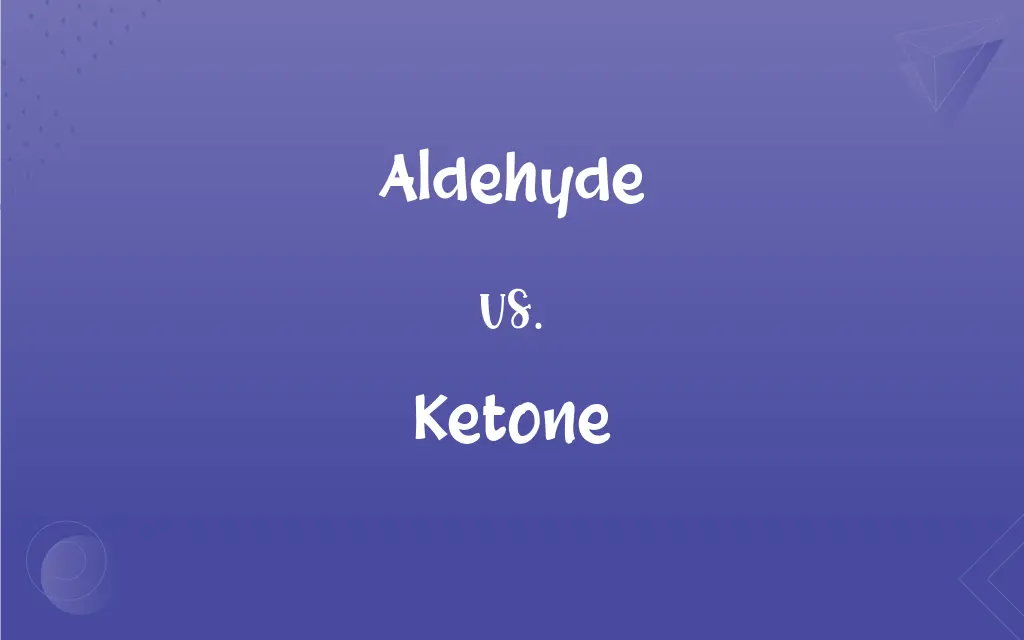Aldehyde vs. Ketone: What's the Difference?
Edited by Janet White || By Harlon Moss || Updated on October 23, 2023
Aldehydes have a carbonyl group (C=O) bonded to a hydrogen atom or carbon, while ketones have the carbonyl group bonded between two carbon atoms.

Key Differences
Aldehydes are organic compounds characterized by a carbonyl group, which is a carbon atom double-bonded to an oxygen atom. In aldehydes, this carbonyl group is bonded to either a hydrogen atom or a carbon atom. This gives them the general formula RCHO, where R represents a carbon chain or a hydrogen atom. Ketones, on the other hand, also contain a carbonyl group. However, in ketones, the carbonyl group is bonded to two carbon atoms. Their general formula is RCOR', where R and R' can be the same or different carbon chains.
When it comes to naming, aldehydes and ketones follow different conventions. Aldehydes usually end with "-al," for instance, methanal or ethanal. Ketones typically end with "-one," like propanone or butanone. The placement of the carbonyl group also influences the nomenclature, especially for aldehydes, as they're always at the end of the carbon chain.
Aldehydes can be oxidized easily to form carboxylic acids. However, ketones are generally more resistant to oxidation. This difference in reactivity is frequently used in organic chemistry reactions to distinguish between the two. On the other hand, both aldehydes and ketones can undergo reduction reactions, but the products of these reactions differ based on the compound type.
From a physical property perspective, both aldehydes and ketones are polar due to the presence of the carbonyl group. This means they can form hydrogen bonds with water, making them somewhat soluble in water. However, as the carbon chain length increases, the solubility in water decreases for both aldehydes and ketones.
Comparison Chart
General Formula
RCHO (Carbonyl group bonded to H or C)
RCOR' (Carbonyl group between two C atoms)
ADVERTISEMENT
Naming Convention
Ends with "-al"
Ends with "-one"
Oxidation
Easily oxidized to carboxylic acids
Resistant to oxidation
Position of Carbonyl Group
Always at the end of the carbon chain
Anywhere within the carbon chain
Example
Methanal, Ethanal
Propanone, Butanone
Aldehyde and Ketone Definitions
Aldehyde
Derivatives of alcohols where the hydroxyl group is replaced by a carbonyl group.
Benzaldehyde gives bitter almonds their characteristic scent.
ADVERTISEMENT
Ketone
Chemicals characterized by the RCOR' structure.
Methyl ethyl ketone is used in paint removers.
Aldehyde
Organic substances with a formyl group.
Vanillin, an aldehyde, is used as a flavoring agent in foods.
Ketone
Derivatives of secondary alcohols with a carbonyl group.
Fructose, a sugar, contains a ketone group.
Aldehyde
An organic compound with a carbonyl group bonded to a hydrogen or carbon atom.
Formaldehyde is a simple aldehyde used in resins and disinfectants.
Ketone
Organic substances containing a ketonic carbonyl group.
Camphor is a natural ketone used in medicinal applications.
Aldehyde
Chemicals characterized by the RCHO structure.
Acetaldehyde is an aldehyde found in ripe fruits.
Ketone
An organic compound where a carbonyl group is bonded to two carbon atoms.
Acetone is a common ketone used as a solvent.
Aldehyde
A chemical featuring a terminal carbonyl group.
The smell of fresh-cut grass is partly due to an aldehyde called hexanal.
Ketone
Compounds with a carbonyl group not at the end of the carbon chain.
Cyclohexanone is a ketone used in nylon production.
Aldehyde
Any of a class of highly reactive organic chemical compounds obtained by oxidation of primary alcohols, characterized by the common group CHO, and used in the manufacture of resins, dyes, and organic acids.
Ketone
Any of a class of organic compounds, such as acetone, characterized by having a carbonyl group in which the carbon atom is bonded to two other hydrocarbon groups and having the general formula R(CO)R′, where R may be the same as R′.
Aldehyde
(organic compound) Any of a large class of reactive organic compounds (R·CHO) having a carbonyl functional group attached to one hydrocarbon radical and a hydrogen atom.
Ketone
See ketone body.
Aldehyde
A colorless, mobile, and very volatile liquid obtained from alcohol by certain processes of oxidation.
Ketone
(organic compound) A homologous series of organic molecules whose functional group is an oxygen atom joined to a carbon atom—by a double bond—in a carbon-hydrogen based molecule.
Aldehyde
Any compound having the group -CHO. Methyl aldehyde, the simplest aldehyde, is more commonly called formaldehyde, H-CHO, and acetic aldehyde is now more commonly called acetaldehyde. The higher aldehydes may be solids. A reducing sugar typically contains the aldehyde group.
Ketone
One of a large class of organic substances resembling the aldehydes, obtained by the distillation of certain salts of organic acids and consisting of carbonyl (CO) united with two hydrocarbon radicals. In general the ketones are colorless volatile liquids having a pungent ethereal odor.
Aldehyde
Any of a class of highly reactive chemical compounds; used in making resins and dyes and organic acids
Ketone
Any of a class of organic compounds having a carbonyl group linked to a carbon atom in each of two hydrocarbon radicals
FAQs
How do the naming conventions differ between aldehydes and ketones?
Aldehydes typically end in "-al," while ketones end in "-one."
Are both aldehydes and ketones polar compounds?
Yes, both aldehydes and ketones are polar due to their carbonyl groups.
What is the primary functional group in an aldehyde?
The primary functional group in an aldehyde is a carbonyl group bonded to a hydrogen or carbon atom, while in a ketone, it's bonded between two carbon atoms.
What's a common test to distinguish between aldehydes and ketones?
The Tollens' test is commonly used; aldehydes reduce the silver solution to form a mirror, while ketones do not.
Which is responsible for the aroma of vanilla?
Vanillin, an aldehyde, is responsible for vanilla's aroma, while acetone, a ketone, has a distinct solvent smell.
Can ketones undergo aldol condensation?
Yes, ketones can undergo aldol condensation, and so can aldehydes.
Can ketones form hydrogen bonds with themselves?
No, ketones cannot form hydrogen bonds with themselves, and neither can aldehydes.
Which has a higher boiling point: aldehydes or ketones?
Typically, ketones have higher boiling points than aldehydes of similar molecular weight.
Are aldehydes more reactive than ketones?
Yes, aldehydes are generally more reactive than ketones due to the presence of the hydrogen atom.
What type of isomerism can aldehydes and ketones exhibit?
Both aldehydes and ketones can show tautomeric isomerism.
Can aldehydes be easily oxidized?
Yes, aldehydes can be easily oxidized, whereas ketones are more resistant to oxidation.
Can aldehydes undergo nucleophilic addition reactions?
Yes, aldehydes can undergo nucleophilic addition reactions, and so can ketones.
Which is found in the oxidation of alcohol?
Aldehydes are formed from the oxidation of primary alcohols, while ketones are formed from secondary alcohols.
Which has a carbonyl group at the end of the carbon chain?
Aldehydes have the carbonyl group at the end, while in ketones, it can be anywhere within the chain.
How are aldehydes and ketones prepared in the lab?
Aldehydes are often prepared by oxidizing primary alcohols, while ketones result from the oxidation of secondary alcohols.
Which is a naturally occurring ketone in our body?
Beta-hydroxybutyrate is a naturally occurring ketone in our body, while methanal, an aldehyde, is not naturally prevalent.
Can ketones be turned into aldehydes?
It's challenging to convert ketones directly into aldehydes, but aldehydes can be easily converted to ketones.
What is a common use of the ketone acetone?
Acetone, a ketone, is widely used as a solvent, while formaldehyde, an aldehyde, is used in resins.
Are both aldehydes and ketones soluble in water?
Both aldehydes and ketones with short carbon chains are soluble in water due to their carbonyl group.
What is the product when ketones are reduced?
When ketones are reduced, they form secondary alcohols, while aldehydes form primary alcohols.
About Author
Written by
Harlon MossHarlon is a seasoned quality moderator and accomplished content writer for Difference Wiki. An alumnus of the prestigious University of California, he earned his degree in Computer Science. Leveraging his academic background, Harlon brings a meticulous and informed perspective to his work, ensuring content accuracy and excellence.
Edited by
Janet WhiteJanet White has been an esteemed writer and blogger for Difference Wiki. Holding a Master's degree in Science and Medical Journalism from the prestigious Boston University, she has consistently demonstrated her expertise and passion for her field. When she's not immersed in her work, Janet relishes her time exercising, delving into a good book, and cherishing moments with friends and family.






























































